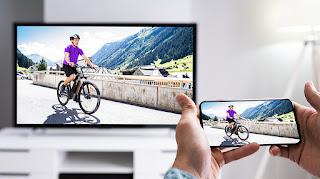The small screen of your Android phone lets you magically cast or mirror your phone’s screen to a nearby TV with just a few taps, giving you a better view of everything you want. Aside from a comfortable viewing experience, the cast screen comes in handy if you want to play a few rounds of Among Us or show everyone that you can’t get enough of the latest TikTok trends. Here’s how you can start mirroring or casting your Android phone or tablet’s screen to your TV. Let’s have a look!

Everything you need to mirror your Android phone to your TV
You need an Android phone or tablet running Android 5.0 or higher. This version of Android was released in 2014, so your phone or tablet is most likely running a newer version of Android. You can check by opening the settings app and going to about phone and looking for the Android version.
In addition to an Android phone or tablet, you’ll also need a Google Chromecast streaming device, such as the recently released Chromecast with Google TV, a TV with Chromecast built in, or a smart display like the Google Nest Hub. If you don’t know if your TV supports Chromecast, the best way to check is to see if it shows up as an available casting device when you follow one of the methods below.
Cast your screen to your TV using the Google Home app
The most reliable and consistent way to mirror your Android phone‘s screen is to use the Google Home app. If you’ve set up any of Google’s smart speakers, Nest Wifi, or Chromecast devices, you probably already have it. If not, you can download it from the Play Store.
Open the Home app and select the Chromecast device you want to use. There will be a button at the bottom of the screen labeled Cast my Screen; tap it. You have to accept the prompt reminding you that whatever is on your phone screen will be visible on your TV to anyone in your room. You may also see a second prompt warning you if your device is not optimized for mirroring. To stop casting your screen, tap the button in the Home app labeled Stop Mirroring.
There is an easier way, depending on your phone
There’s an easier way: use the casting shortcut in the quick settings panel. Swipe down from the top of your Android phone or tablet’s display to access the quick settings panel. There should be an option labeled Screen cast, once you find the Screen cast button, select it, and select the device from the list on which to mirror the display. It may take a few seconds for your phone to connect to your Chromecast-enabled device, but once connected, your screen will appear on your TV. Stop casting by repeating the same steps we just outlined.
But here’s the thing: Not every phone includes a cast button option in the quick settings panel. You can still mirror your phone using the Home app.
>>>>>>>>>>Phone battery
Thanks for reading, hope it helps!
Friendly reminder: If you need to replace the battery, this battery store will be a good choice: www.batteryforpc.co.uk









